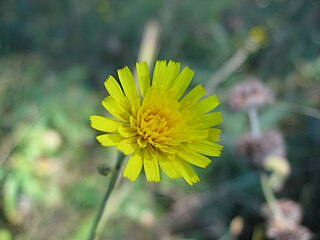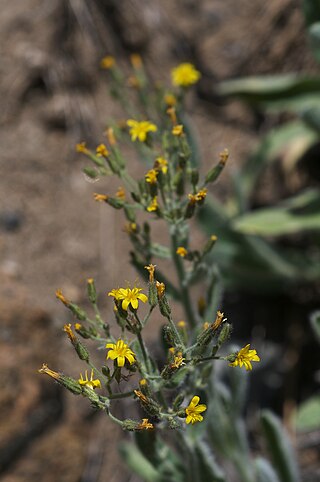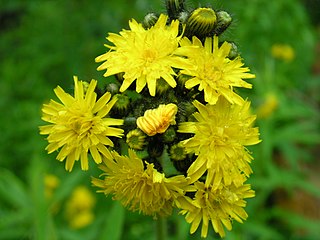
Hieracium , known by the common name hawkweed and classically as hierakion, is a genus of flowering plant in the family Asteraceae, and closely related to dandelion (Taraxacum), chicory (Cichorium), prickly lettuce (Lactuca) and sow thistle (Sonchus), which are part of the tribe Cichorieae. Hawkweeds, with their 10,000+ recorded species and subspecies, do their part to make Asteraceae the second largest family of flowering plants. Some botanists group all these species or subspecies into approximately 800 accepted species, while others prefer to accept several thousand species. Since most hawkweeds reproduce exclusively asexually by means of seeds that are genetically identical to their mother plant, clones or populations that consist of genetically identical plants are formed and some botanists prefer to accept these clones as good species whereas others try to group them into a few hundred more broadly defined species. What is here treated as the single genus Hieracium is now treated by most European experts as two different genera, Hieracium and Pilosella, with species such as Hieracium pilosella, Hieracium floribundum and Hieracium aurantiacum referred to the latter genus. Many members of the genus Pilosella reproduce both by stolons and by seeds, whereas true Hieracium species reproduce only by seeds. In Pilosella, many individual plants are capable of forming both normal sexual and asexual (apomictic) seeds, whereas individual plants of Hieracium only produce one kind of seeds. Another difference is that all species of Pilosella have leaves with smooth (entire) margins whereas most species of Hieracium have distinctly dentate to deeply cut or divided leaves.
A dry roadside dotted with small, ¾ inch red orange flowers, interspersed with very similar yellow ones, and often the white of daisies, is a good sign that you are in Hawkweed country.

Pilosella officinarum, known as mouse-ear hawkweed, is a yellow-flowered species of flowering plant in the daisy family Compositae, native to Europe and northern Asia. It produces single, lemon-coloured inflorescences. Like most hawkweed species, it is highly variable and is a member of a species complex of several dozens of subspecies and hundreds of varieties and forms. It is an allelopathic plant.

The Botanical Society of Britain and Ireland (BSBI) is a scientific society for the study of flora, plant distribution and taxonomy relating to Great Britain, Ireland, the Channel Islands and the Isle of Man. The society was founded as the Botanical Society of London in 1836, and became the Botanical Society of the British Isles, eventually changing to its current name in 2013. It includes both professional and amateur members and is the largest organisation devoted to botany in the British Isles. Its history is recounted in David Allen's book The Botanists.

Hieracium albiflorum, known by the names white hawkweed and white-flowered hawkweed, is a common and widespread species of plant in the family Asteraceae.
Hieracium snowdoniense, the Snowdonia hawkweed, is a species of flowering plant within the family Asteraceae. The species is endemic to Snowdonia, North Wales.

Hieracium lachenalii, also known as common hawkweed or yellow hawkweed, is a species of plant in the tribe Cichorieae within the family Asteraceae. It is native to Europe but has become established as a weed in Australia and parts of North America. The species was widely known for many years as H. vulgatum, but more recent studies have indicated that the two names represent the same species. The name H. lachenalii was coined in 1802, H. vulgatum in 1819, so the older name is to be used.

Pilosella caespitosa is like several other Pilosella species and has a similar appearance to many of the hawkweeds.

Hieracium sabaudum, also known as New England hawkweed, European hawkweed or a Savoy hawkweed, is a European species of plants in the tribe Cichorieae within the family Asteraceae. It is native to Europe but has become naturalized in parts of North America. In Canada, it grows in British Columbia, Québec, and Nova Scotia. In the United States, it has been found in Washington state in the Northwest as well as Wisconsin and the Northeast. The species is considered a noxious weed in Washington state.

Hieracium horridum, known as the prickly hawkweed or shaggy hawkweed, is a species of plant in the family Asteraceae. It gets its name from the long, dense, shaggy white to brown hairs (trichomes) which cover all of the plant parts of this plant species. The species is native to Oregon, California, and Nevada in the western United States.

Hieracium scouleri, known as Scouler's woollyweed, is a species of flowering plant in the tribe Cichorieae within the family Asteraceae. It is native to western North America, from British Columbia and Alberta in Canada, and south to northern California and Utah in the United States.

Hieracium venosum is a species of hawkweed in the tribe Cichorieae within the family Asteraceae. It is widespread and common in south-central Canada (Ontario) and the eastern United States. Its common name comes from the fact that environments it is found in are typically also a home to rattlesnakes.

Hieracium piloselloides is a species of flowering plant in the family Asteraceae known by the common name tall hawkweed. It is native to Europe and it is present in North America as an introduced species and a common weed.

Pilosella floribunda is a species of noxious and herbaceous perennial plant from family Asteraceae that is known in Europe and can also be found in United States and Canada. It was believed that it was a hybrid of Pilosella caespitosa (Hieracium caespitosum and Pilosella lactucella.

Pilosella lactucella is a species of perennial plant from the family Asteraceae, found in Europe, New York and Nova Scotia (Canada). It is 9–20 centimetres (3.5–7.9 in) in height, with stems from 1–2 millimetres (0.039–0.079 in) wide. The leaves are spatula shaped and 5–8 centimetres (2.0–3.1 in) wide. The flowers bloom from May to July, the heads of which are 2–5 centimetres (0.79–1.97 in) tall. It was once described by Carl Linnaeus as Hieracium auricula and Pilosella auricula, but was recategorized by A. E. Roland and M. Zinck in 1998.

Hieracium scabrum, commonly known as rough hawkweed or sticky hawkweed, is a North American plant species in the tribe Cichorieae within the family Asteraceae. It is native to the eastern and central United States and Canada.

Hieracium naviense is a very rare species of hawkweed which has been given the common name of Derby hawkweed.
Hieracium bakerianum is a species of hawkweed.
Hieracium stewartii is a species of flowering plant belonging to the family Asteraceae.
Hieracium duriceps is a species of flowering plant belonging to the family Asteraceae.













